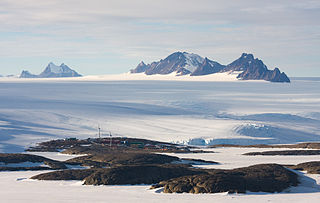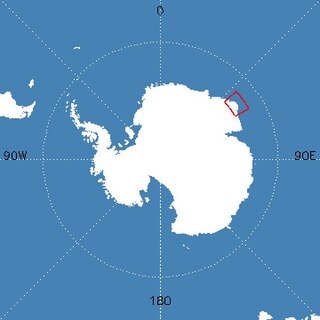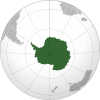
Mawson Station, commonly called Mawson, is one of three permanent bases and research outposts in Antarctica managed by the Australian Antarctic Division (AAD). Mawson lies in Holme Bay in Mac. Robertson Land, East Antarctica in the Australian Antarctic Territory, a territory claimed by Australia. Established in 1954, Mawson is Australia's oldest Antarctic station and the oldest continuously inhabited Antarctic station south of the Antarctic Circle. It houses approximately 20 personnel over winter and up to 53 in summer.

Lambert Glacier is a major glacier in East Antarctica. At about 80 km (50 mi) wide, over 400 km (250 mi) long, and about 2,500 m (8,200 ft) deep, it is the world's largest glacier. It drains 8% of the Antarctic ice sheet to the east and south of the Prince Charles Mountains and flows northward to the Amery Ice Shelf. It flows in part of Lambert Graben and exits the continent at Prydz Bay.
Cape Ann is a cape on the coast of East Antarctica, surmounted by Mount Biscoe rising to a peak of 700 metres.
Mount Codrington is a prominent mountain, 1,520 metres (5,000 ft) high, standing 24 miles (39 km) south-southeast of Cape Close, 17 miles (27 km) east of Johnston Peak, and 11 miles (18 km) south of Simmers Peaks. Mount Codrington forms the northeastern end of the Napier Mountains.
The Tula Mountains are a group of extensive mountains lying immediately eastward of Amundsen Bay in Enderby Land, Antarctica. They were discovered on January 14, 1930, by the British Australian New Zealand Antarctic Research Expedition (BANZARE) under Mawson and named "Tula Range" by him after John Biscoe's brig, the Tula, from which Biscoe discovered Enderby Land in 1831. The term "mountains" was recommended for the group following an ANARE sledge survey in 1958 by G.A. Knuckey.
The Napier Mountains are a group of close set peaks, the highest being Mount Elkins, at about 2,300 meters above sea level. This mountain range is located in Enderby Land, in the claimed Australian Antarctic Territory, East Antarctica.
The Scott Mountains are a large number of isolated peaks lying south of Amundsen Bay in Enderby Land of East Antarctica, Antarctica. Discovered on 13 January 1930 by the British Australian New Zealand Antarctic Research Expedition (BANZARE) under Sir Douglas Mawson. He named the feature Scott Range after Captain Robert Falcon Scott, Royal Navy. The term mountains is considered more appropriate because of the isolation of its individual features.

Enderby Land is a projecting landmass of Antarctica. Its shore extends from Shinnan Glacier at about 67°55′S44°38′E to William Scoresby Bay at 67°24′S59°34′E, approximately 1⁄24 of the earth's longitude. It was first documented in western and eastern literature in February 1831 by John Biscoe aboard the whaling brig Tula, and named after the Enderby Brothers of London, the ship's owners who encouraged their captains to combine exploration with sealing.

Mount Biscoe is a distinctive black peak, the easternmost and largest of two ice-free rock massifs located 6 km south-west of Cape Ann on the coast of Enderby Land in Antarctica. About 700 m in height, it lies 7 km north-west of Wordie Nunatak, and 7 km north-east of Mount Hurley.

The geology of Antarctica covers the geological development of the continent through the Archean, Proterozoic and Phanerozoic eons.

Mount Kjerringa is an isolated peak, 1,220 metres (4,000 ft) above sea level, situated roughly 8 nmi (15 km) north of the Aker Peaks, 26 nmi (48 km) west of Magnet Bay, and 57 km (31 nmi) northeast of Mount Elkins in Enderby Land, East Antarctica.

Terence James Elkins is an Australian-born American physicist. In 1960, he participated in an expedition from Mawson Station which conducted the first geological surveys of the Napier Mountains in Enderby Land, East Antarctica. The highest of this group of mountains, Mount Elkins, was subsequently named after him. In 1979, he received the Harold Brown Award, the United States Air Force's highest honor for research and development, for research he conducted that contributed to the development of the AN/FPS-115, AN/FPS-117 and AN/FPS-118 over-the-horizon backscatter (OTH-B) air defense radar system. Designed to replace the aging Ballistic Missile Early Warning System system, these systems are among the most powerful early-warning radar systems ever developed.
Sydney Lorrimar Kirkby, is an Australian surveyor and Antarctic explorer.

Mount Maines, also known as Stornuten, is a mountain, 2,190 metres (7,190 ft), standing roughly 13 kilometres (8.1 mi) SE of Stor Hånakken Mountain and 10 kilometres (6.2 mi) W of Mount Elkins in the Napier Mountains, Enderby Land.
Rippon Glacier is a small glacier located in Kemp Land, East Antarctica. It is close east of Seaton Glacier, flowing southward into Edward VIII Ice Shelf.
Mount King is a large, smooth-crested mountain in the eastern extremity of the Tula Mountains. Part of the Australian Antarctic Gazetteer and the SCAR Composite Gazetteer of Antarctica, it is located in Enderby Land, East Antarctica, which is claimed by Australia as part of the Australian Antarctic Territory. The head of Beaver Glacier is located very close to the base of Mount King.

Armstrong Peak is a peak, 1,470 metres (4,820 ft) high, standing 15 nautical miles (28 km) southeast of Mount Codrington in Enderby Land of East Antarctica.

The Wilkinson Peaks, also known as Langnabbane, is a group of peaks in the Napier Mountains standing 8 kilometres (5.0 mi) southeast of Mount Griffiths and 8 kilometres (5.0 mi) northeast of Mount Elkins in Enderby Land.
Mount Weller is a mountain, 1,080 m, standing west of Auster Glacier and 2 nautical miles (3.7 km) east of Reference Peak in Enderby Land. It was plotted from air photos taken by ANARE in 1956 and was named by the Antarctic Names Committee of Australia (ANCA) for G.E. Weller, a meteorologist at Mawson Station in 1961.









